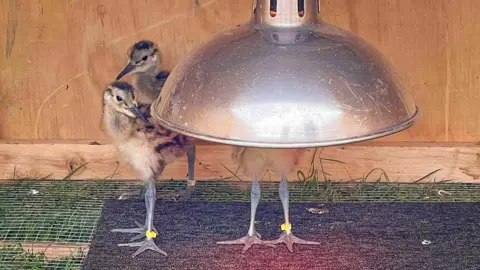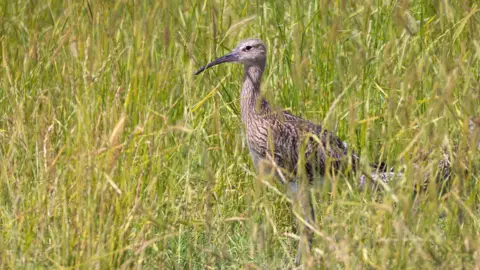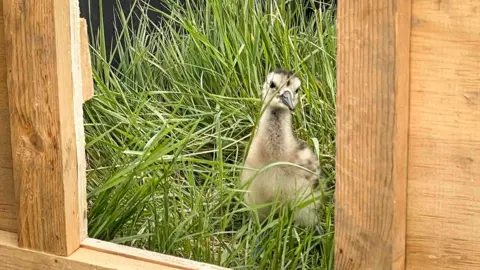Curlew chicks hatch in Kent conservation project
 Yvette Austin/BBC
Yvette Austin/BBCA Kent nature reserve is playing a key role in efforts to revive southern England's dwindling curlew population.
Thirty-nine chicks have successfully hatched and are being raised in captivity as part of a project to save one of Britain's most iconic wading birds from local extinction.
The chicks, hatched from eggs collected in northern England, are being cared for at Elmley Nature Reserve on the Isle of Sheppey.
They are due to be released into the wild later this summer.
 Yvette Austin/BBC
Yvette Austin/BBCCurlews, easily recognised by their long, down-curved bills and haunting calls, are Europe's largest wading birds.
They nest on the ground and are typically seen feeding on tidal mudflats and salt marshes.
Populations in southern England have plummeted in recent decades due, it is thought, to habitat loss and high numbers of predators such as foxes.
Reserve manager Gareth Fulton said: "The reason for the project is that curlews in southern England, basically everything south of Birmingham, are down to about the last 200 pairs and they need to produce more chicks per year to sustain their population.
"So they're going to go extinct here in 20 years if no one does anything."
Elmley is one of three sites involved in the South of England Curlew Project supported by the Game and Wildlife Conservation Trust (GWCT).
They have officially been granted a licence from Natural England to receive and rear curlew eggs.
Mr Fulton said they are working closely with experts in the Yorkshire Dales, where the curlew population is healthier.
They identify where nests have been made in vulnerable locations, such as near a footpath or in fields that will be cut for grass before the chicks are ready.
He said: "The experts watch the nests, know when the eggs are laid and know when they're ready to move.
"They're incubated in Yorkshire for a few weeks before being brought here."
Conservationists believe captive-rearing gives the birds the best chance of survival during their vulnerable early stages.
 Yvette Austin/BBC
Yvette Austin/BBCWith 3,300 acres of wet grassland and meadows, alongside salt marsh and mudflats of the River Swale, Elmley offers a protected environment for the birds to thrive.
Curlews typically breed in the same area where they themselves were raised.
Therefore, the hope is the chicks will return to breed at the reserve when they are mature.
With this being the third year of the project, conservationists are looking out for returning birds and hopefully nests in 2026.
